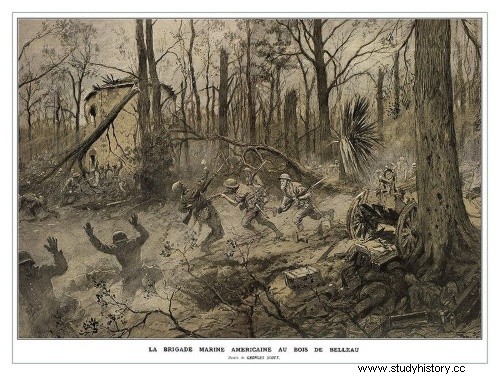
The Battle of Belleau Wood is a battle of the First World War. It was of great psychological importance, as it marked the first engagement of American troops from the American Expeditionary Force, placed under the command-in-chief of General John Pershing, as well as the start of the great Allied counter-offensive of 1918.
It took place in the woods located south-west of Belleau (Aisne), very close to the Marne, between June 1 and June 26, 1918 and opposed a unit of the Second Indianhead Infantry US division, composed of the 23rd Infantry Regiment and from a brigade of Marines under the command of General James G. Harbord, to the German forces entrenched in the area of Château-Thierry.
It holds the sad record for the number of American soldiers killed in a single battle until World War II.
The Battle of Belleau Wood is still considered today as the first major engagement and the founding event of the reputation of the Marines. They send a delegation each year for Memorial Day, as well as for the July 4th celebration.
Fighting
On May 27, 1918, following the German offensive on the Chemin des Dames, the French lines were broken down to a depth of 50 km, between Noyon and Reims. On May 31, the 2nd American Division, 26,665 strong, including 1,063 officers, received the order to form a solid defensive line in the Château-Thierry sector. Immediately resuming the offensive following the directives of General Foch, the French Sixth Army put the 2nd DI to the test of fire.
On the night of June 5, the Marines and the 23rd American Infantry Regiment (the 9th Infantry Regiment being in reserve) counter-attacked and gained a foothold in Belleau Wood. On June 6, a battalion of the 23rd Infantry Regiment lost 27 killed and 225 wounded. On June 10, the Marines of General James G. Harbord forced the south of Belleau Wood. After two days, they reduce the points of resistance, take 500 prisoners, seize 35 machine guns and their reserves of ammunition. Subjected for ten days to violent counter-attacks, they managed on June 25 to drive out the last Germans who were clinging to the northern corner of the wood. They take another 300 prisoners and, in the process, seize the village of Bouresches.
After three weeks of combat, the wood was completely conquered on June 24. During this time the 9th infantry regiment blocked the road to the Marne 1.5 km from Château-Thierry. During the night of July 1, the attack on Vaux was led by the 23rd Infantry Regiment commanded by Colonel Malone. The 2nd Division was relieved on July 6 by the 26th American Division.
Military Quotes
A few days later, General Degoutte, commanding the French Sixth Army, proclaimed on the agenda:
"Because of the brilliant conduct of the 4th Marine Brigade of the 2nd United States Infantry Division, which seized Bouresches with great struggle and the stronghold of Bois Belleau fiercely defended by a numerous adversary, General commander of the Sixth Army decides that in all official documents, Bois Belleau will henceforth bear the name of Bois de la Brigade des Marines. »
By Order No. 10805 "D" of the French General Headquarters, of October 22, 1918 signed by General Commanding-in-Chief Philippe Pétain, the 4th American Brigade under the command of Brigadier General James G. Harbord and composed:
of the 5th Marine Regiment under the command of Colonel Wendell C. Nevill;
of the 6th Marine Regiment under the command of Colonel Albertus W. Catlin;
of the 6th Machine Gun Battalion under the command of Major Edward W. Cole;
will receive a citation to the Order of the French Army for this decisive battle.
USS Belleau Wood
In memory of these exploits, an American light aircraft carrier will take, in the middle of the Pacific war in 1942, the name of USS Belleau Wood (CVL-24). From 1953 to 1960, under the French flag, she was the aircraft carrier Bois Belleau.
From 1978 to 2005, the name USS Belleau Wood (LHA-3) was again given to an American warship, an assault helicopter carrier assigned to the Pacific Fleet and based in Sasebo, Japan. Able to move at 20 knots, it can land a landing force of 2,000 Marines and accommodates 6 vertical take-off aircraft, 23 helicopters, its raft concealing barges of various types.
